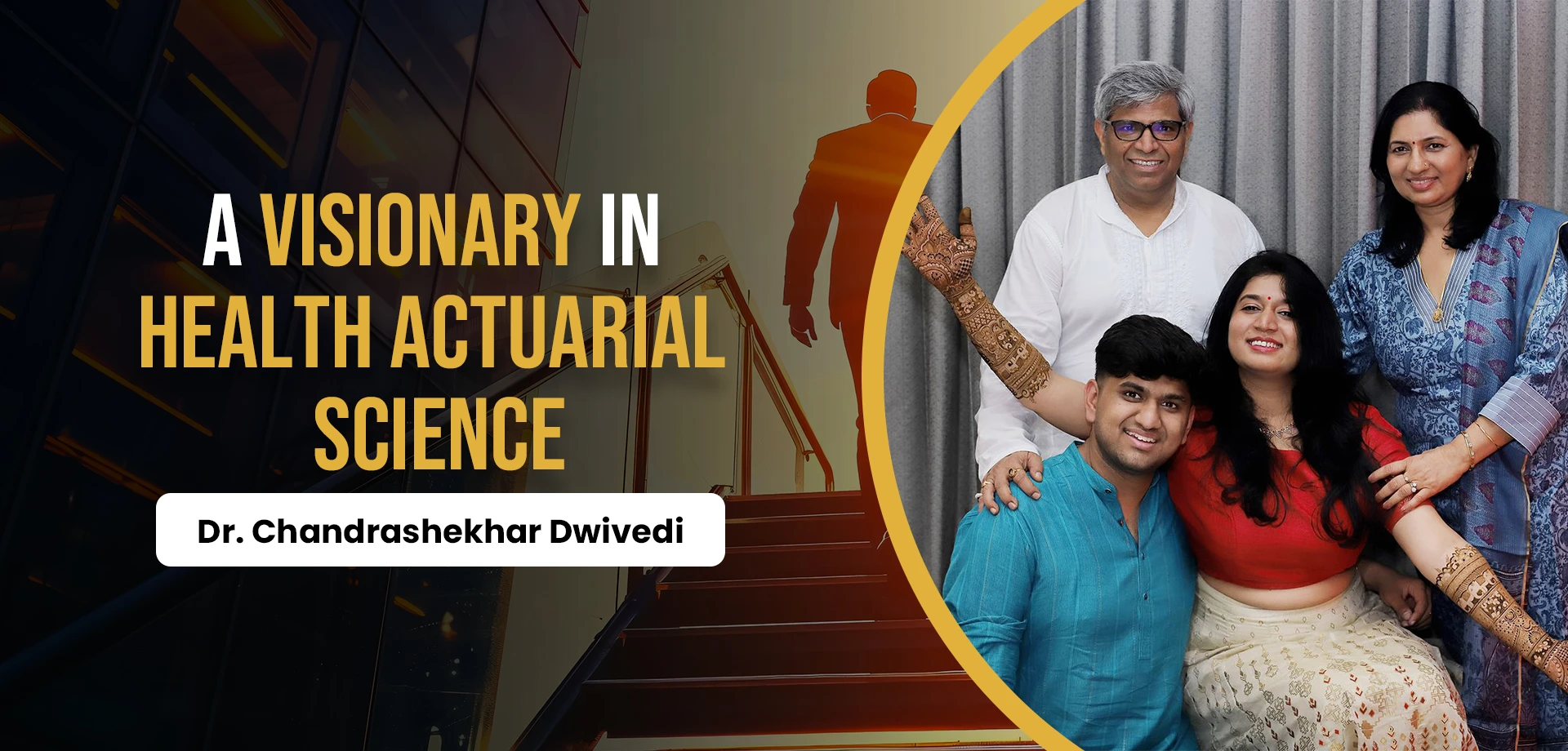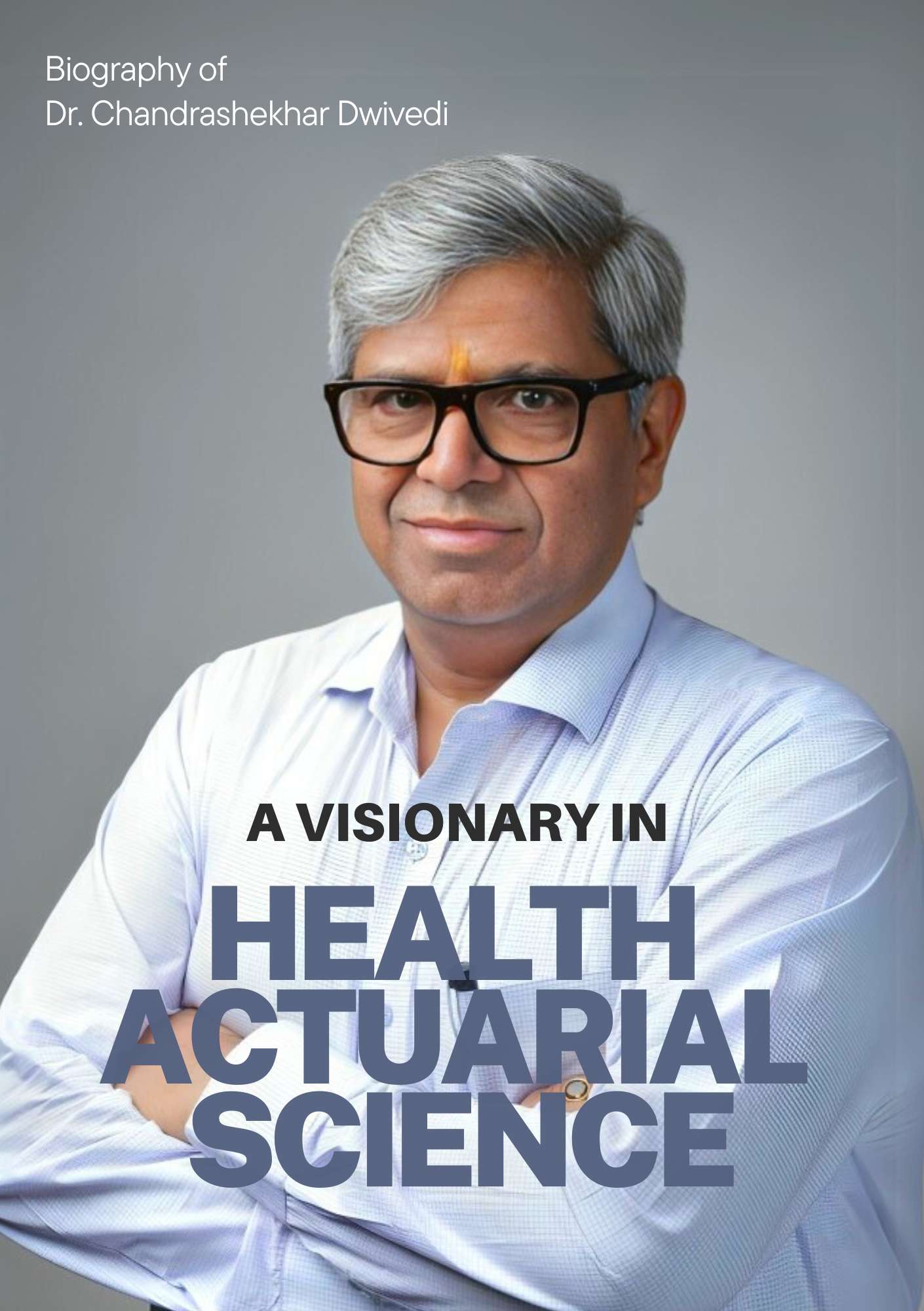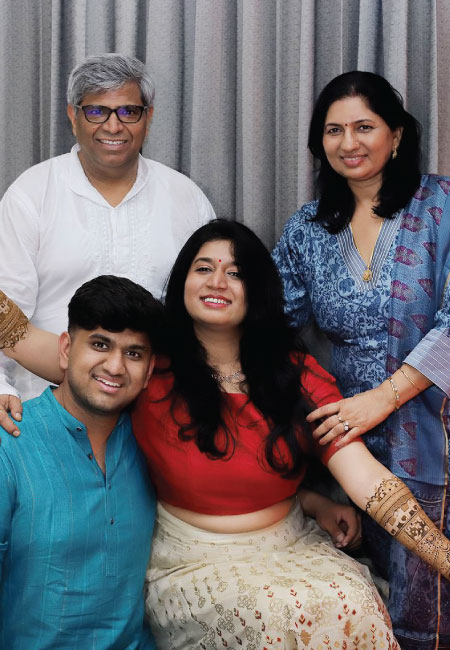

"In the middle of every difficulty lies opportunity."
Introduction
In a world driven by numbers, policies, and predictions, very few rise above the technicalities to shape a legacy rooted in purpose, people, and progress. Dr. Chandrashekhar Dwivedi is one such remarkable figure—a man whose journey spans industries, defies conventions, and reflects the transformative power of visionary leadership.
From humble beginnings in Kanpur, where his dreams of becoming a professor were sown, to becoming one of India’s most respected health actuaries, Dr. Dwivedi’s life is not merely a story of professional success—it is a story of courage, intellect, empathy, and reinvention. His 33-year journey—from engineering and telecommunications to leading strategic innovation in the insurance sector—is marked by milestones that speak volumes of his relentless pursuit of excellence.
Whether it was spearheading 35% business growth during a global crisis, or pioneering health products tailored to the nuanced needs of women, youth, and the differently abled, Dr. Dwivedi brought a human touch to a data-driven world. His leadership during the pandemic didn’t just outpace industry benchmarks—it redefined what actuarial science could achieve when led with both head and heart.
This biography unfolds the chapters of his life in a storytelling format, capturing not just events, but the values, motivations, and resilience that shaped them. It brings to life his role as a mentor, innovator, strategist, and above all, a lifelong learner, who never let success distance him from humility.
In these pages, readers will find more than just a professional chronicle—they will find a roadmap of inspiration. For students, actuaries, entrepreneurs, and dreamers alike, Dr. Dwivedi’s life is a guiding light that proves one truth: “Greatness is not just what you accomplish, but what you inspire others to do.” Welcome to the story of Dr. Chandrashekhar Dwivedi—a legacy in motion.
Phase 1 : A Dream Takes Root
“T he only limit to our realization of tomorrow is our doubts of today.”

Dr. Chandrashekhar Dwivedi’s story begins in the industrious city of Kanpur, Uttar Pradesh—a city humming with the sounds of machines, the chatter of marketplaces, and the quiet dreams of countless families striving for a better future. Born into a humble household, Dr. Chandrashekhar was raised in an environment where discipline, integrity, and perseverance were not just virtues—they were a way of life. His father, a devoted employee at the ordnance factory in Kanpur, exemplified dedication. Despite the long commutes and the demands of his profession, he always made time to impart life lessons to his children, often reminding them that greatness is not a matter of birth, but of effort and will.
From the earliest days of his childhood, young Chandrashekhar exhibited an unusual curiosity about the world around him. He was not content with simply knowing what things were—he yearned to understand why they were. While other children played outside, he was often found poring over books, sketching diagrams, or asking questions that left even adults speechless. School became more than a routine for him; it was a sanctuary where his dreams took flight. Teachers noted his sharp intellect and deep-seated passion for learning. It was during these formative years that the seed of a powerful dream was planted—to become a professor, not just to teach, but to inspire, to spark change, and to illuminate minds.
For Dr. Chandrashekhar, the role of a professor symbolized more than academic achievement—it was a mission. He envisioned himself in front of a classroom, not merely delivering lectures but igniting the flames of ambition in the hearts of students. He dreamed of nurturing thinkers, of challenging the status quo, and of becoming a guiding force in the intellectual journey of others. What he didn’t foresee, however, was that his ambition would soon grow beyond the boundaries of chalkboards and lecture halls.
deployment under demanding timelines. Dr. Chandrashekhar approached the challenge with characteristic tenacity and a visionary mindset. He established meticulous project protocols, implemented quality assurance mechanisms, and empowered his teams with the tools and training needed to execute the job flawlessly. His leadership ensured that the project not only met its targets but exceeded expectations in terms of efficiency, coverage, and long-term sustainability.
Perhaps even more impactful was his role in commissioning the STM-16 Fiber Optic transmission system—a high-capacity, ultra-modern backbone for digital communication. Under his supervision, this system was deployed with precision, enhancing bandwidth capabilities, streamlining network operations, and dramatically improving the quality of telecom services across the region. The STM-16 system, with its advanced Synchronous Digital Hierarchy (SDH) architecture, was instrumental in reducing signal loss, enhancing data transmission speeds, and bringing next-generation communication infrastructure to a region previously plagued by outdated systems. This deployment not only elevated the service standards for BSNL customers but also resulted in significant operational cost savings for the organization.
Phase 2 : Engineering the Future
“Success is not in what you have, but who you are.”
As the quiet yet determined boy from Kanpur matured into a young man, his passion for learning intensified, becoming an unquenchable fire that propelled him toward higher aspirations. With a resolute heart and a sharp intellect, Dr. Chandrashekhar Dwivedi earned admission into one of the most prestigious engineering institutions of the region—Harcourt Butler Technological Institute (HBTI), Kanpur. Known for its rigorous academic environment and tradition of producing top-tier engineers, HBTI became the perfect crucible in which his ideas, skills, and identity as an innovator began to take shape. Enrolled in the Electrical Engineering program, Dr. Chandrashekhar immersed himself in the world of currents, circuits, and systems, driven not only by the desire to graduate with a degree but by a genuine fascination with the science and impact of engineering. In 1991, he proudly graduated with a B.Tech in Electrical Engineering—an achievement not just of academic merit, but a testament to years of discipline, curiosity, and the unwavering support of his family.
Armed with this qualification, Dr. Chandrashekhar stepped into the world of professional engineering with confidence and clarity of purpose. His first assignment came with Orient Paper & Industries Ltd., a company that provided him with the opportunity to translate theoretical knowledge into tangible impact. Tasked with leading the electrical maintenance unit of a Captive Power Plant, Dr. Chandrashekhar quickly distinguished himself from his peers. While many new engineers would spend years simply adapting to the work environment, Dr. Chandrashekhar was already thinking ahead—reimagining systems, questioning traditional approaches, and seeking ways to optimize operations. His approach was not reactive but visionary.
One of his most remarkable early contributions came through his transformative work on the plant’s coal-fired boiler system. Rather than accepting the inefficiencies of the existing system as a norm, he dared to ask: What if we could do this better? Guided by his problem-solving mindset and deep technical insight, he spearheaded a groundbreaking transition—converting the conventional boiler into a modern Fluidized Bed Combustion (FBC) system. This was no small feat. The FBC technology required not only a nuanced understanding of combustion processes and thermal dynamics but also meticulous planning and the ability to manage change at a systemic level. His leadership throughout this conversion was marked by both technical brilliance and practical wisdom. By implementing this upgrade, Dr. Chandrashekhar didn’t just improve fuel efficiency and environmental compliance—he revolutionized the power generation model for the company.
This period of his career was more than just a technical chapter; it was a defining era that showcased the essence of who Dr. Chandrashekhar truly was—not just an engineer, but a visionary with the courage to challenge convention and the skill to turn ideas into innovation. His ability to lead change, think beyond the obvious, and commit to excellence laid the groundwork for a future filled with even greater possibilities. “Success is not in what you have, but who you are,” and in these early years, Dr. Chandrashekhar had already shown that his success would not be measured by titles or positions, but by the transformative impact he would leave wherever he went.
Phase 3 : The Call of Telecom
“Opportunities don’t happen. You create them.”

By the mid-1990s, India stood at the threshold of a technological revolution. The winds of liberalization were sweeping across the country, opening doors to new industries and transforming the economic landscape. At this pivotal juncture, Dr. Chandrashekhar Dwivedi found himself drawn toward a field that was fast becoming the backbone of modern infrastructure—telecommunications. In 1997, fuelled by a desire to make a broader impact and apply his engineering acumen to a sector of national importance, he made a strategic career pivot. He joined Bharat Sanchar Nigam Limited (BSNL), one of India’s largest and most critical public sector telecom enterprises, as a Sub-Divisional Engineer. It was a move that would not only redefine his professional journey but also position him as a key architect in the evolution of India’s communication networks.
At BSNL, Dr. Chandrashekhar was quick to establish a reputation as a results-oriented, forward-thinking engineer with an exceptional ability to manage complex projects. What set him apart was not just his technical prowess, but his deep understanding of systems integration, stakeholder management, and the transformative potential of cutting-edge technology. Over the course of the next 17 years, he took on increasingly ambitious roles and responsibilities, each time raising the bar for excellence. Among his most remarkable achievements was his leadership of a massive 8,000-kilometer Optical Fiber Cable (OFC) communication project that spanned the length and breadth of Uttar Pradesh (East), one of the most populous and infrastructure-challenged regions in the country.
The magnitude of this undertaking was immense. Planning and executing an optical fiber network across thousands of kilometers meant navigating diverse terrains, managing logistics on an unprecedented scale, coordinating with multiple departments, and ensuring timely